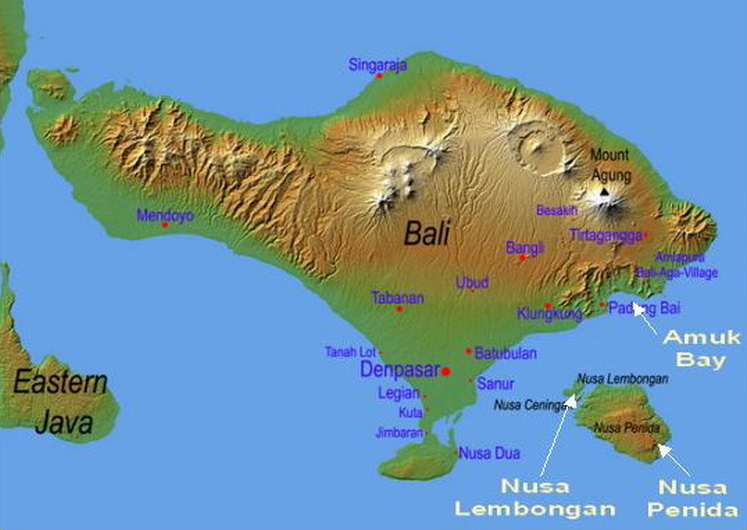Scuba Diving Bali – Location, Location, Location, as they say in the Real Estate business, is everything… And the islands location at the south-west tip of the Coral Triangle means that the scuba diving in Bali just has to be good!
The Coral Triangle is generally considered to be the richest marine environment in the world. Covering six countries in total, the Coral Triangle stretches from the Philippines in the north. All the way to the Malaysian state of Sabah in the west and the Solomon Islands to the east. With Indonesia, East Timor and Papua New Guinea in between.
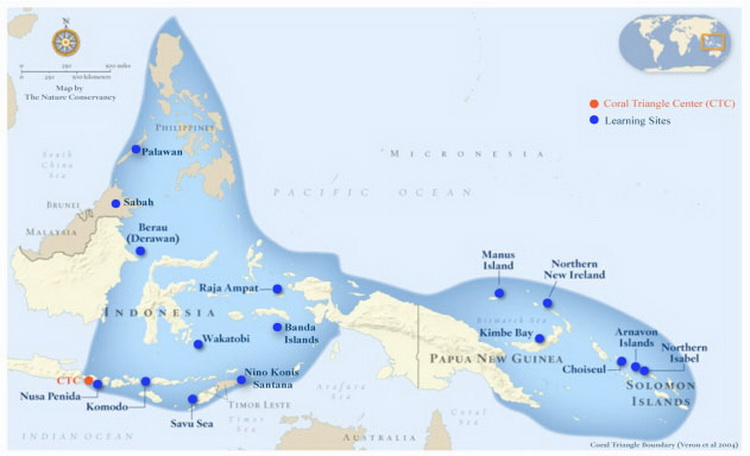
The area’s marine biodiversity is simply stunning. And is characterized by more than 600 species of coral and 3000 species of reef fish. To put those numbers into perspective – the Red Sea has around 200 coral species and 1000 fish species while the Caribbean has 50 and 900 respectively.
For more information on the Coral Triangle check out the Nature Conservancy’s dedicated site.
The Indonesian Throughflow
Bali plays a major role with the Indonesian Throughflow. The phenomenal flow of water which is so big, that special measurements had to be created for it! And is an integral part of the Coral Triangle’s incredible biodiversity.
The Lombok Strait, between the islands of Bali and Lombok, is one of three major channels that the Throughflow exits the Indonesian archipelago.
It is estimated that around 20% of the Throughflow passes through the Lombok Strait. Providing the reefs on the east and northeast coastlines of Bali, and those on the nearby islands of Nusa Lembongan and Nusa Penida, with a constant flow of water extremely rich in organic nutrients, planktonic eggs and larvae.
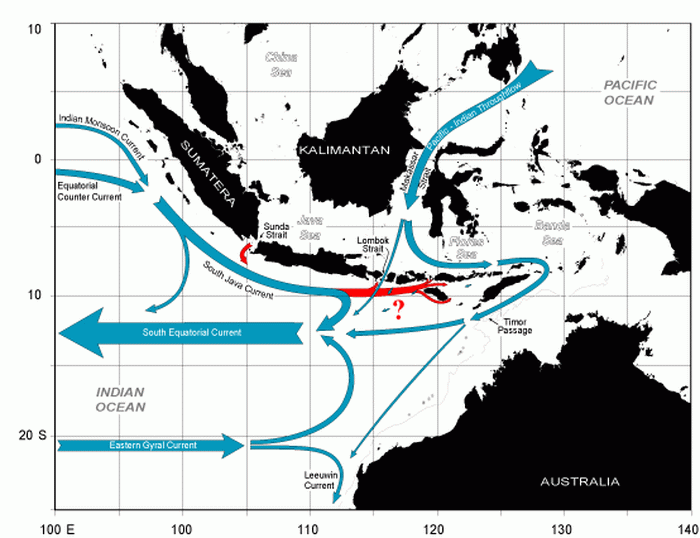
All of these factors combine to make for some great diving in Bali. But the island just does not have the street cred of say Sulawesi or Raja Ampat… Probably because of its touristy reputation.
Scuba diving Bali can be separated into five distinct areas: The northwest region, the north coast, the northeast coast and the east coast, which includes Nusa Lembongan and Nusa Penida.
There is actually a 6th area – the south coast. But I have never been diving there and have heard nothing about it that would make me want to…
Diving Bali – The Northwest
There are three main areas of interest in the northwest of Bali. With the first, and by far the largest, being the island of Menjangan.
Menjangan Island was where diving first really started in Bali back in about 1978 under the sponsorship of the Indonesian Navy. There are several dive sites around the island and I have yet to dive all of them. But have documented my experience so far on the Diving Menjangan Island page.
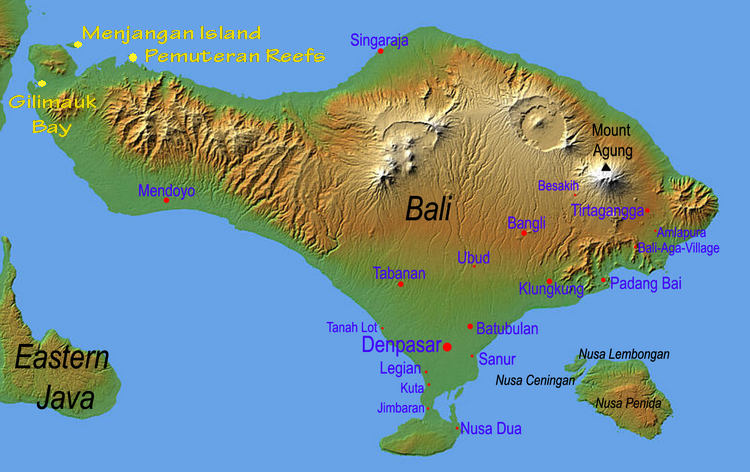
The second main area is a kind of “must do” for underwater photographers and critter lovers – Gilimanuk Bay. Or as it is more commonly known Secret Bay…
Quite what is secret about Secret Bay is somewhat of a mystery in itself. But it is an interesting place and well worth a visit if you like to see or photograph some of the weird and wonderful creatures the sea has to offer.
But if blue water and beautiful coral reefs are your thing – don’t bother, as you will be greatly disappointed. My experience and images taken at Secret Bay are documented on its dedicated page.
The third area is the reefs at Pemuteran, which I have never personally dived. But from what I understand the reefs were badly damaged by unusually warm (El Nino produced) sea temperatures. That was way back in 1998, but the reefs have still not fully recovered.
I hope to dive this area soon and will update this information.
Diving Bali – The North Coast
There are two areas of interest on the north coast of Bali: Lovina Reef and the critter site Puri Jati which is more commonly known as PJ.
Lovina is a pleasant town and I usually stay there when diving in the area. But have never actually dived Lovina Reef. What I have heard though is that while it’s OK, it’s mainly a spot for new open water divers. Which probably tells you all you need to know about it…
That said, I will check it out one of these days and update these pages.
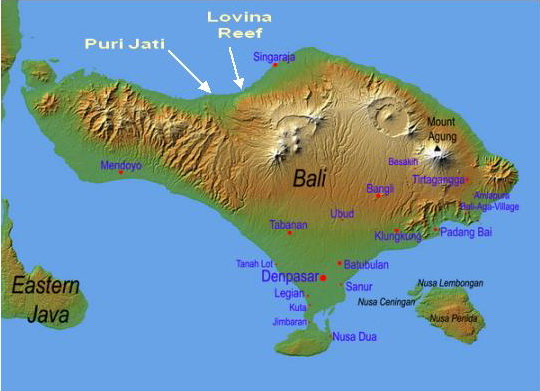
Puri Jati on the other hand is somewhere I have spent a lot of time diving and thoroughly enjoyed it.
PJ is like Secret Bay but without all the accumulated rubbish. In that it’s very much a site for seeing and photographing critters and my experiences are documented on the dedicated Puri Jati page.
Diving Bali – The Northeast Coast

If there is one location that defines scuba diving in Bali it is the small town of Tulamben and it’s main attraction of the Liberty shipwreck, which attracts divers from all over the world!.
There is no doubt that the wreck is a great site. But there are several other sites in the general area that can keep even the most discerning diver busy for days… Such as the Drop-Off at the southern end of Tulamben Bay and the sites around the headland from there.
My experience & images from diving the Liberty wreck are documented on its dedicated page. And I recently completed a whole new section of this site called the Insider’s Guide to the Liberty Wreck. Which is based on six days on diving the Liberty Wreck up to 5 times a day to really get to know it and its pulse. It was a great experience which I documented in the Insider’s Guide to the Liberty Wreck.
Just 3km southeast of Tulamben is Seraya where you can find a wonderful selection of critters on the Seraya Secrets house reef right in front of the two main resorts there.
Check out the dedicated page for my experience & images from diving Seraya.
Diving Bali – The East Coast
The East Coast of Bali offers some tremendous, but often quite challenging diving… The reason that the diving is so good, but why great care is required, are one and the same thing- the Indonesian Throughflow.
In terms of the science of hydrology, the Lombok Straits are where “the rubber meets the road”. And it is there that you will potentially face some of the strongest currents you are likely to experience anywhere.
But currents are the life-force of the sea. They bring with them the things as divers we want to see and I highly recommend the area. But make sure you use a good operator who has experienced guides, as they really are the key to safe diving on the East Coast of Bali.
There are three main areas to dive on the East Coast – Amuk Bay, Nusa Lembongan and Nusa Penida and my experiences & images are documented on these dedicated pages.
